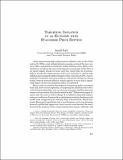| dc.contributor.author | Galí, Jordi | |
| dc.date.accessioned | 2019-11-01T00:01:36Z | |
| dc.date.available | 2019-11-01T00:01:36Z | |
| dc.date.issued | 2002 | |
| dc.identifier.isbn | 956-7421-102 | |
| dc.identifier.uri | https://hdl.handle.net/20.500.12580/3669 | |
| dc.description | After experiencing high and persistent inflation rates in the 1970s and early 1980s, most industrialized economies entered the new century with a sustained record of flow, stable inflation rates. Many commentators attribute the new environment to good luck, in the form of no major supply shocks (at least until the recent hike in oil prices). Others invoke the magic powers of the new economy to explain why inflation has remained subdued despite robust economic growth. | |
| dc.format | .pdf | |
| dc.format.extent | Sección o Parte de un Documento | |
| dc.format.medium | p. 271-294 | |
| dc.language.iso | eng | |
| dc.publisher | Banco Central de Chile | |
| dc.relation.ispartof | Series on Central Banking, Analysis, and Economic Policies, no. 5 | |
| dc.rights | Attribution-NonCommercial-NoDerivs 3.0 Chile | * |
| dc.rights.uri | http://creativecommons.org/licenses/by-nc-nd/3.0/cl/ | * |
| dc.subject | INFLACIÓN | es_ES |
| dc.subject | PRECIOS | es_ES |
| dc.subject | DESARROLLO ECONÓMICO | es_ES |
| dc.title | Targeting inflation in an economy with staggered price setting | |
| dc.type.doc | Artículo | |
| dc.file.name | BCCh-sbc-v05-p271_294 | |


